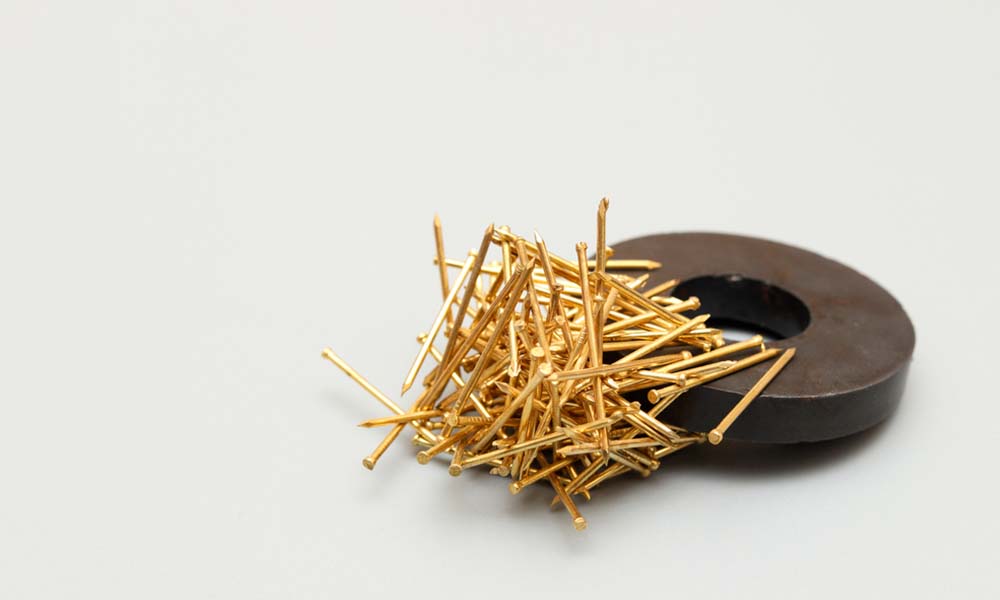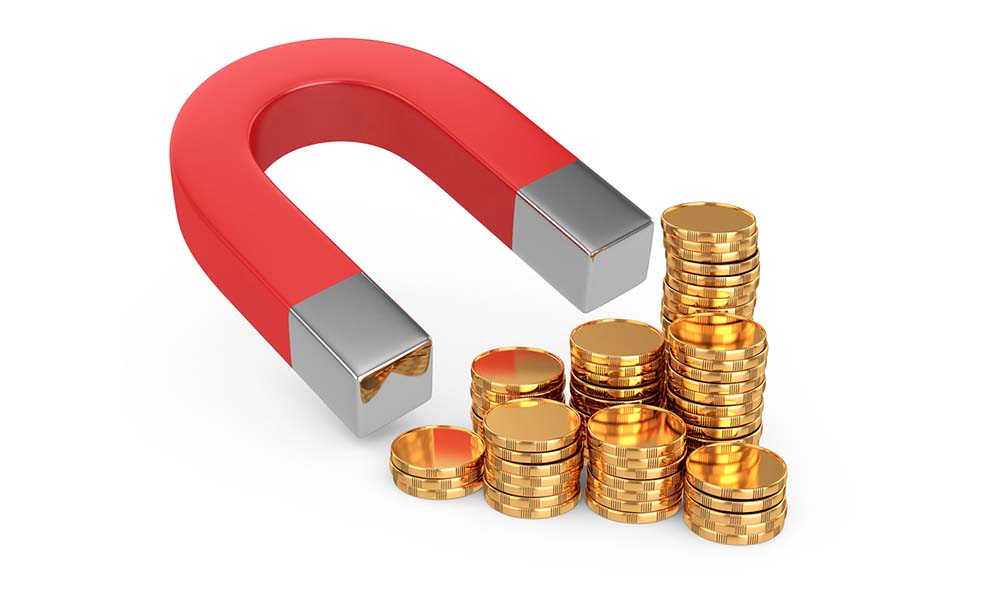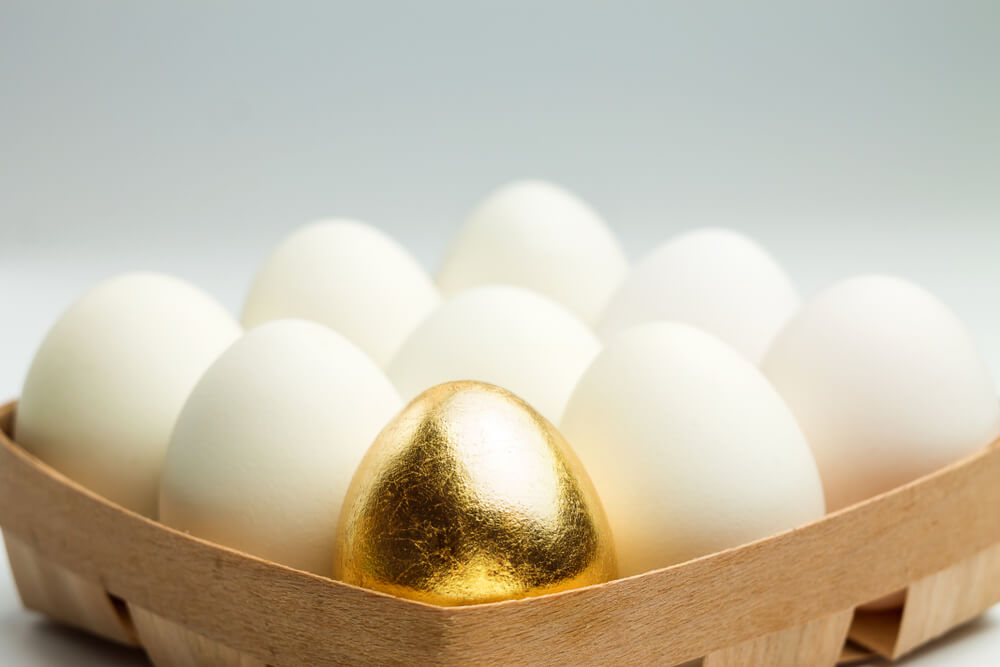
Is Gold Magnetic?
Contrary to general perception, not every metal attracts a magnet. The majority are not magnetic. Metals that stick to magnets are only a handful: iron, cobalt, nickel, and a few rare earth metal alloys. The non-magnetic list is much longer, comprising copper, brass, silver, lead, etc. The list goes on.
The big question is, “Is gold magnetic?”. The short answer is “no”. The slightly longer answer is it depends on the kind of “magnetism” being referred to. If you thought magnetism only means metals physically sticking to magnets, you’re only partially correct.
Feeling perplexed already? Do not worry, and read on to clear the air and understand the subject comprehensively.

In this article, you’ll learn about:
- Magnets and their major classifications
- The fundamentals of magnetism (ferromagnetism, diamagnetism, paramagnetism, etc.)
- Gold and its relationship with magnetism
- The chances of turning gold magnet-friendly, etc.
Pure gold has specific characteristics that lend it the prestige and value it currently upholds. The lack of apparent magnetism bodes well for the yellow metal. Or does it?
Table of Contents
What is a Magnet?
A magnet is any object or material that creates a “magnetic field”. Magnets have a wide range of applications than most imagine. They are used in fans, window frames, compasses, electronic components, electrical equipment, electronic instruments, electrical conductors, high-speed trains, many musical instruments, etc.
Magnets could be natural (such as lodestone) or human-made. Lodestone is an iron-rich rock. Items that can turn into a magnet include iron, nickel, and cobalt. Our Earth is a massive magnet, thanks to the magnetic materials it contains as molten rock.
Types of Magnets
Magnets are primarily classified as:
- Permanent magnet: A permanent magnet is a natural and strong magnet that stays magnetic indefinitely and without any influences from outside. Permanent magnets retain magnetic properties at all times. They are used in everyday items, such as electric motors, fridge magnets, audio speakers, etc. Alnico and ferrites are examples.
- Temporary magnet: Temporary magnets, as the name indicates, remain magnetic for a short period. Materials such as iron nails, paperclips, etc., can be turned into temporary magnets briefly.
- Electromagnet: An electromagnet is also a human-made magnet. Its magnetic field is courtesy of an electric current. Electromagnets come in handy in different applications.
Read more: Getting Gold From Electronics
Why are Some Metals Magnetic and Some Not?

All elements (metals and non-metals) have certain magnetic traits to them. The inherent magnetism is not always apparent in most.
The items (metals) that attract magnets have magnetic properties. Referred to as “ferromagnetic metals”, they have a thing in common — their valence shells (outermost shells) comprise unpaired electrons.
For an object to be “magnetic”, unpaired electron(s) in its farthest orbit is essential (besides meeting a few other technical requirements). The free-spinning nature or movement of those unpaired electrons induces magnetism.
The more non-paired electrons in the valence (outermost) shell, the greater the physical affinity for magnets they’ll exhibit. Iron, for instance, has four unpaired electrons in its last shell. Nickel has two.
Some Non-Metals Could Also Exhibit Magnetic Traits
Not all metals are magnetic, but a magnetic material is always metal. The kind of magnetism those metals possess is called “ferromagnetism”, as alluded to above. It’s not induced or created externally. It’s inherent. Interestingly, “ferrum” is “iron” in Latin. Iron and the other materials mentioned above are ferromagnetic materials.
Paramagnetism
With external intervention, a non-ferromagnetic metal can be made to exhibit magnetic traits, albeit partially. The phenomenon is referred to as “paramagnetism”. Non-metals could also be made to act slightly magnetic or assume magnetic properties through paramagnetism.
Paramagnetism denotes the existence of a magnetic field. When positioned within a magnetic space, non-ferromagnetic materials could exhibit magnetism. Materials that assume magnetic traits through paramagnetism are “paramagnetic materials”.
Paramagnetism in some metals could be too weak to be noticeable. You may not be able to check the magnetism of paramagnetic materials using a regular magnet. But a highly sensitive instrument, such as a magnetometer (gaussmeter), would help measure it.
Diamagnetism
The opposite of ferromagnetism is diamagnetism. A diamagnetic object repels a magnet. Paramagnetism sits between the two. If a material is not ferromagnetic or paramagnetic, it’s diamagnetic. Aluminum, magnesium, platinum, tungsten, etc., are paramagnetic materials. Zinc, tin, silver, copper, and gold represent the diamagnetic clan.
To see the various forms of magnetism in action, watch this video:
The Curious Case of “Stainless Steel”
Without straying much from the primary topic, it’s essential to understand that some alloys are magnetic or non-magnetic based on their unique composition.
Steel, particularly the “stainless” kind, is composed of different materials (carbon, chromium, iron, manganese, phosphorus, silicon, etc.) — which ascertain whether the material assumes magnetic properties or not.
The more ferromagnetic materials the steel is made of, the more magnetic it becomes. Typically, steel is mostly iron (98-99%), so most steel items stick to magnets.
In the case of stainless steel, the iron composition could vary significantly. It is much lower than the amount found in regular steel since room has to be made for other materials — such as chromium (10.5%, minimum). The chromium in stainless steel protects the material from corrosion and increases its heat-resistant properties.
“Self-Healing” Stainless Steel
Chromium envelopes the entire steel surface, forming an oxide film. The oxide film is just two to three nanometers thick. The layer self-repairs or eliminates surface-level scratches or blemishes since chromium rapidly reacts with moisture and oxygen in the environment, reforming the oxide layer.
Stainless steel’s corrosion resistance could be boosted by increasing the alloy’s chromium content, besides adding molybdenum to the mix. Nitrogen is added to the steel for increased pitting resistance and mechanical strength.
Some gold plating could be essentially stainless steel covered with thin sheets or a thin layer of pure gold. Real gold is, however, never among the core metals or the underlying metal in steel.
Why is Real Gold Not Magnetic?
Pure gold is a dense material. The metal is also known for its low reactivity, high electrical conductivity, and high melting point. It’s also non-magnetic.
So, what is pure gold like at its chemical composition level, and how does that relate or not relate to magnetism?
Real gold has one unpaired electron in its farthest shell. The unpaired electron doesn’t render gold magnetic because there’s more to magnetism (or ferromagnetism) than just having an unpaired valence electron(s).
The electron’s orbital magnetic moment, nuclear magnetic moment, crystalline structure, etc., have major roles to play too. Elements with an unpaired electron in their outmost shell could act paramagnetic or diamagnetic.
Pure gold is diamagnetic. Copper is another diamagnetic material with a single unpaired valence electron. Aluminum, on the other hand, has an unpaired electron, but it acts paramagnetically when placed in a magnetic field.
Silver is also not naturally magnetic like the precious metal, which means white gold is not magnetic. But it can be turned diamagnetic when part of a “science experiment” or placed in a magnetic field.
How Does a Metal Detector Find Gold?
A metal detector incorporates sensor probes to detect metals. The technology it employs is called “electromagnetism” — which is, in highly simplified terms, “electricity marrying magnetism”. Electricity can be used to generate magnetism and vice-versa.
The detector doesn’t magnetically pull the gold or any other metal toward it, which is why it works with detecting gold. When the sensor in the metal detector is close enough to a metal, the device gives out noise or beep signaling the presence of the metal.
Metal detectors can be used to find a wide range of metals, including gold and other precious metals. But not all metal detectors detect gold. Certain types do, and some do not.
There are two major metal detector types:
- VLF (shallow frequency): VLF detectors use a fixed, single detecting frequency — usually falling in the 6 to 20 kHz range.
- PI (pulse induction): The PI-type metal detectors employ pulsed signals and higher frequencies. Thanks to the high-frequency waves, PI detectors can pick up things embedded much deeper into the ground than the VLF machines.
Some manufacturers or sellers could custom-design a metal detector and coin a new name for the technology used.
To find gold, you’ll need a metal detector that employs high frequencies since pure gold transmits electrical energy a lot better with high-frequency waves. In other words, the PI metal detector is best equipped to find gold. Sensors that employ multiple frequencies also come in handy.
How effective the technology is, however, would depend on specific models. An entry-level PI detector would not be as good as a higher-end model detecting buried gold coins or nuggets.
Do your research. If the detector’s product description or marketing material has no mention of gold, grow skeptical.
Can You Make Gold “Magnetic”?

If the term “magnetic” denotes “physical attraction”, gold can be made magnetic, provided external intervention is permitted.
As mentioned earlier, the precious metal acts diamagnetically or repels a magnet instead of sticking to it when positioned within a magnetic field. When the magnet comes exceptionally close to a piece of gold, the metal will feebly or ever-so-slightly move the magnet away.
How to Create a Magnetic Field?
A laboratory environment is needed to create the ideal magnetic field wherein electricity must be run through a wire. Magnetic fields are created by setting charged particles into motion.
A powerful electromagnet can also be used to create a magnetic field. Electromagnets help power tiny electronic switches and also lift large scrap metal pieces. The strength of the magnetic field is contingent on the:
- Winding’s density
- Volume of current running via the magnet, and
- Wire-wrapped material.
For a stronger magnetic field, hook up the magnet with a power supply. But don’t pour in too much power as the circuit breaker could then trip or overheat.
Kindly note, the experiment is hardcore, pure science. If you are not a scientist who has carried out chemical tests before, do the testing under an expert’s strict supervision.
Reducing Karat Numbers and Magnetism
The purity of a gold article – be it a piece of gold jewelry, a gold coin or bullion coins, etc. – is determined by the amount of precious yellow metal in the item. The karat system helps ascertain the same.
Gold articles typically fall in the 24K to 10K karat range. 24K is pure gold or no adulteration of any sort. A piece of 22K gold means other metals have been added to the mix. The lower the karat number (22K, 18K, 14K, etc.), the lesser the gold amount in the piece of gold.
Does the Inclusion of Other Metals Cause Gold to Turn Magnetic?
The other metals typically blended with gold lend gold coins, gold jewelry, etc., for increased sturdiness and durability include silver, copper, zinc, platinum, etc. None of these metals are ferromagnetic. Nickel is perhaps the only metal to have strong magnetic properties.
When mixed with nickel, gold could assume magnetic traits. But, unlike silver and copper, nickel is not as commonly used with gold. Nickel tends to cause allergic reactions in some people. Iron is also seldom added to gold.
When iron or nickel is mixed with gold, the gold alloy does assume certain magnetic qualities. But how much depends on the proportions.
Read more: Types of Gold
Conclusion
It’s not clear why people want to know is gold magnetic. Maybe they don’t understand what gold gains by not being one of the magnetic metals. There’s some solid molecular science reasoning to look at, which this article has explained in the most straightforward manner possible. If gold were magnetic, it would have likely not been the precious metal everyone deems it to be.
Now that you clearly understand gold is not magnetic, try learning a few other essential attributes or concepts relating to the yellow metal. Peruse our site and check out the other articles we have painstakingly put together to help you learn something new. If you are considering investing in gold in the future or are a gold investor, knowing more about the precious metal is critical.
FAQs
How to discern real gold from fake gold?
If you were gifted a piece of gold jewelry and wanted to confirm its authenticity, do a hallmark test or check the hallmark sign. Then, conduct a basic magnet test. No need to head to the local jewelry store to check gold authenticity.
If the gold jewelry sticks to the magnet, it’s not real gold – unless and until the gold is not 24K or pure gold and uses nickel as the other metal. If the other metals added are silver or copper, the gold article would not attract the magnet.
But just because the magnet does not attract gold, it doesn’t necessarily imply the item is pure gold or homogenized with permissible metals. It could be fake gold, or it is quite possible the gold item is impure gold jewelry, gold plated, or the gold content isn’t enough for the item to qualify as gold.
If you are still not sure or believe the gold item is fake gold and not real gold, get some proper testing done. In other words, take the gold item to a gold jeweler or dealer you trust.
Why is iron not mixed with gold in jewelry or other gold items?
Iron is highly corrosive – which means it reacts with the moisture and oxygen present in the air. In other words, iron rusts. It’s, therefore, not made to work with precious metals.
Rust not just looks terrible or causes the piece of gold jewelry to lose its luster, but it can also feel uncomfortable when it comes in direct contact with your skin and stays put there for extended periods. Pure or sterling silver and copper have an inherent luster that complements gold pretty well. Iron lacks that charm. It’s more industrial.
Another reason iron is not commonly mixed with gold is the rigidity of the former. Gold is often beaten and turned into jewelry, gold coins, etc. Also, gold and iron have different melting points, which could cause issues when you heat them together if they were an alloy. In other words, the gold alloy would no longer be malleable enough for recycling and repurposing reasons with iron in the mix.
At times, iron could be found in gold, or the clasps on jewelry could be made from the metal.
Is gold partially paramagnetic?
There are a few unproven claims about gold being magnetic (ferromagnetic) at a nano level. But because those atoms are very few compared to the several non-magnetic particles in the element, the alleged magnetism is not visible (to the naked eye or under a microscope). It likely gets entirely wiped out at the molecular level itself.



